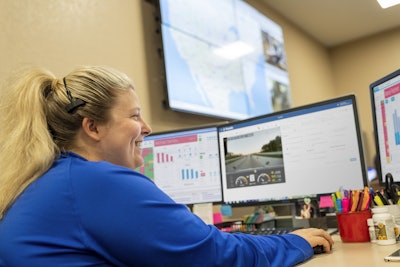Driver safety and compliance data pours in from disparate systems as information from driver qualification files, electronic logging devices (ELDs), vehicle telematics and video event recorders rarely comes through a single source.
 COVID-19 has created more demand for managed compliance services as fleets thinned their offices and set up employees to work from home.
COVID-19 has created more demand for managed compliance services as fleets thinned their offices and set up employees to work from home.The options to channel this abundant data include using technology to unite it in a common database for real-time analysis and workflow automation, as well as using managed services to lighten the burden. More fleets are using a combination of both to free up resources and gain needed insights to be more proactive in managing risks.
Events in 2020 have acted as a catalyst for fleets to revisit these strategies. Many have moved their offices to virtual work environments and have needed to provide workers better access to data and documents.
Additionally, the Federal Motor Carrier Safety Administration (FMCSA) has ramped up its offsite compliance reviews during COVID-19, which has made it necessary to respond to auditors’ requests more quickly to review records and safety practices.
Driving integration
Some technology suppliers have developed products that bring data together into a central database to provide fleet managers and frontline workers with a unified dashboard to manage the full driver employment lifecycle.
EBE Technologies’ InfoStream starts with recruiting by gathering driver motor vehicle reports (MVRs), Pre-Employment Screening Program (PSP) reports and other background records. Once a driver is hired, the software gives users a holistic view of compliance and safety from roadside inspections, ELDs and critical events captured by telematics, cameras and other sources.
 InfoStream from EBE Technologies integrates with various systems to allow carriers to more efficiently track and manage DOT and FMCSA compliance.
InfoStream from EBE Technologies integrates with various systems to allow carriers to more efficiently track and manage DOT and FMCSA compliance.The InfoStream platform has a configurable scoring system for driver safety and compliance. Users can view scores and drill down to see the individual elements. InfoStream also has artificial intelligence (AI) that alerts users to action items and an automated workflow that assigns and documents training among other corrective actions, said Larry Kerr, chief executive for EBE.
If a driver has a single hard-braking event, the fleet may not want to assign an action unless the event meets additional criteria. If a driver has two hard-braking events within one hour, this could be a threshold for an action item, Kerr said.
The system can send a corrective action letter to drivers to sign via smartphone to acknowledge the type of event that occurred on a given day, time and place. Once signed, the document is saved to the driver’s personnel file. A corrective training module to accompany the event could be assigned automatically.
InfoStream is able to detect more complicated risk patterns by monitoring data from cameras, roadside inspections, ELDs and other systems. If an accident occurs, fleets could use the software to instigate the forms and checklists they need to ensure a complete file to manage claims, Kerr said.
As technology advances, fleets are able to provide automated coaching to drivers by using AI to analyze driving behaviors and give feedback.
For driver feedback to be effective, coaching has to be given before their next driving session, said Chris Orban, vice president of data science for Trimble Transportation. The coaching message should not just focus on singular negative events but also include positive reinforcement, he said.
 Chris Orban, vice president of data science for Trimble, advises that driver coaching messages should not just focus on singular negative events but include positive reinforcement.
Chris Orban, vice president of data science for Trimble, advises that driver coaching messages should not just focus on singular negative events but include positive reinforcement.Trimble, Orban said, is making a “real push” for its Video Safety Solutions products to provide drivers with the right coaching plan for safety and extend the plan to help them with trip planning. If the cameras detect a long wait at a fuel stop, the system could suggest an alternative fuel location.
“Safety is the primary focus of video and the biggest bang for the buck, but why limit it there?” he said. “If you can save a driver 30 minutes of wait time, that is going to be a safer driver.”
Managed services
Motor carriers that have multiple locations and operating companies are more likely to use technology in combination with managed services.
UniGroup (CCJ Top 250, No. 25), a $1.6 billion transportation company that owns United Van Lines and Mayflower, recently began using Lytx’s Compliance Services program to collect and integrate data from multiple sources that include ELDs, digital timesheets, paper logs, driver qualification documents, roadside inspections and vehicle records.
Melissa Lawson, compliance director for Fenton, Missouri-based UniGroup, said the Lytx program brings disparate data to a centralized location, making it easier to manage and submit records for auditing.
UniGroup’s local drivers use work statements to record their time. Some long-haul drivers use paper logs, but the majority use ELDs. Lytx consolidates and audits data from these records to detect issues related to violations, falsifications and noncompliance.
 UniGroup is behind household goods carriers United Van Lines and Mayflower Transit.
UniGroup is behind household goods carriers United Van Lines and Mayflower Transit.“If a driver’s vehicle or ELD breaks down mid-trip, we can now be confident that their data will still synchronize with our central compliance platform, whether they need to replace the ELD with a different provider or go to a paper log,” Lawson said.
A Lytx dashboard shows users the cause of violations, enabling the application of targeted coaching and training. A web-based accident registry database and reporting system also records a fleet’s DOT-reportable crash history in a single system, which allows fleets to add nonreportable incidents or accidents to track damage and collision trends.
An extension of the team
About three years ago, CRST International (CCJ Top 250, No. 20) engaged Fleetworthy Solutions to lighten the compliance workload of managing its operating divisions with a combined fleet of 6,000 drivers.
“We had a lot of paper and filing cabinets,” recalled Steven Garrish, vice president of safety for the Cedar Rapids, Iowa-based company. “It was quite a challenge.”
Hiring and transferring drivers between CRST’s seven divisions, monitoring logbook data and other routine processes were labor-intensive. To complicate matters, the company has contractor drivers that use more than one ELD system for its Flatbed and Specialized operations.
The safety department also lacked clear visibility of the compliance for each division and the organization as a whole. “We felt we had a high level of compliance in CRST, but not having clear visibility always made us wonder,” Garrish said.
 CRST is using Fleetworthy’s customer-facing web portal, Comply 2.0, to monitor where the fleet stands on compliance and where to focus attention.
CRST is using Fleetworthy’s customer-facing web portal, Comply 2.0, to monitor where the fleet stands on compliance and where to focus attention.Fleetworthy collects and audits CRST’s driver qualification files and hours of service (HOS) data. The HOS data comes in electronically to Fleetworthy through integrations with the fleet’s ELD systems. CRST receives exception reports and guidance to correct violations.
Working with Fleetworthy has lightened the burden of compliance. As a result, CRST no longer needed some employees, but their transition was aided by Fleetworthy hiring them.
Those who changed jobs were “incredibly happy” about the new career, Garrish said. “My team has gotten leaner and smaller but much more efficient,” he said, adding CRST management was able to sharpen its focus and spend more time with drivers on “people-based safety initiatives.”
As a Fleetworthy client, CRST is using the vendor’s customer-facing web portal, Comply 2.0, which Garrish described as a “dashboard for compliance.” Every morning, he has a call with the fleet’s safety team to review metrics in the dashboard, such as the volume and error rates of driver job applications.
Moving forward, Garrish said Comply 2.0 will enable CRST to bring data together from different systems for predictive risk modeling. The system could identify drivers with an elevated risk level by finding data patterns such as HOS violations, speeding events, roadside inspection violations, customer complaints and other possibilities.
“We can build a picture of risk to inform decisions before an accident happens,” he said. “My main goal is to retain drivers and keep them safe by getting ahead of those behaviors.”
Garrish said Fleetworthy does more than store documents and data for CRST. “They act as an extension of our compliance team” by analyzing the quality of information and by “giving us ideas on how to get better.”
“I feel that Fleetworthy gives us a connection to the rest of the industry and what fleets are doing,” he said.
Corrective training
Learning management systems (LMS) can help fleets close the loop on driver safety and compliance. When a risk-related incident occurs, fleets can assign training to drivers and document their completion.
J.J. Keller and Associates tracks the details of drivers’ completed online courses (learner, content, start date, duration, score) in the LMS of its Safe and Smart Driver Training program.
Driver training content is also integrated with the company’s Encompass fleet management system. Trucking clients using the fleet management, ELDs, video, and other products from J.J. Keller can enroll their drivers in training that corresponds to behaviors or activities.
“This more real-time response after an incident can lead to powerful benefits and safety outcomes,” said Steve Murray, vice president of content and consulting services.
Vertical Alliance has developed nearly 1,000 short training modules for its web-based Infinit-I LMS, which is available through a subscription. Vertical Alliance Chief Executive Jay Wommack said about 40% of the content is new, with information that caters to the learning preferences of drivers, including kinetic, visual and auditory.
The Infinit-I LMS tracks drivers’ training completions and includes a separate “roll call” feature that fleets can use to document training done in person or video conference. Infiniti-i has application programming interfaces (APIs) that provide fleets the flexibility to link training completion records with employee files kept in other systems, such as payroll.
 Vertical Alliance has developed nearly 1,000 short driver training modules for its web-based Infinit-I platform that is available through a subscription.
Vertical Alliance has developed nearly 1,000 short driver training modules for its web-based Infinit-I platform that is available through a subscription.Vertical Alliance has expanded its courses beyond driver safety and compliance to include training for insurance, fuel usage and employees’ human resource issues “that pop up all the time,” Wommack said.
For the HR courses, Vertical Alliance has contracted with a professor at Fort Worth’s Texas Christian University (TCU) to create more than 50 videos on the most common issues. It also has created 30 scripts that provide carriers with a quick reference guide on HR issues to save money that otherwise is spent on contacting attorneys for advice, Wommack said.
“It is not just about driver training, but that is where we cut our teeth,” he said.
By gaining better control of safety, compliance and training resources, motor carriers can not only reduce risk but also use their own resources more efficiently. Garrish said CRST now is able to quickly retrieve and share documents with FMCSA officials during offsite compliance reviews, helping the fleet know where they stand and where to focus their attention.











